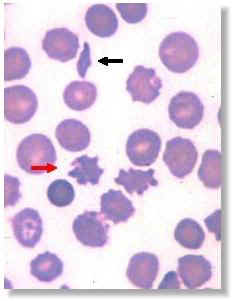Abetalipoproteinemia: Difference between revisions
m (Bot: Automated text replacement (-{{SIB}} + & -{{EH}} + & -{{EJ}} + & -{{Editor Help}} + & -{{Editor Join}} +)) |
Rim Halaby (talk | contribs) No edit summary |
||
| Line 1: | Line 1: | ||
__NOTOC__ | |||
{{SI}} | |||
{{ | |||
{{CMG}} | {{CMG}} | ||
{{SI}} Acanthocytosis, Bassen-Korzweig syndrome, apolipoprotein B deficiency, microsomal triglyceride transfer protein deficiency, MTP deficiency | |||
==Overview== | ==Overview== | ||
Revision as of 15:33, 17 September 2013
Editor-In-Chief: C. Michael Gibson, M.S., M.D. [1]
Acanthocytosis, Bassen-Korzweig syndrome, apolipoprotein B deficiency, microsomal triglyceride transfer protein deficiency, MTP deficiency
Overview
Abetalipoproteinemia is a rare genetic disorder (autosomal recessive) that interferes with the normal absorption of fat and fat soluble vitamins from food. It is not to be confused with dysbetalipoproteinemia.
Features
Abetalipoproteinemia is an inherited disorder that affects the absorption of dietary fats, cholesterol, and certain vitamins. People affected by this disorder are not able to make certain lipoproteins, which are molecules that consist of proteins combined with cholesterol and particular fats called triglycerides. This leads to a multiple vitamin deficiency, affecting the fat soluble vitamin A, vitamin D, vitamin E, and vitamin K. However, many of the observed effects are due to vitamin E deficiency in particular.
The signs and symptoms of abetalipoproteinemia appear in the first few months of life. They can include failure to gain weight and grow at the expected rate (failure to thrive); diarrhea; abnormal star-shaped red blood cells (acanthocytosis); and fatty, foul-smelling stools (steatorrhea). Specifically the stool may contain large chunks of fat and or blood. Other features of this disorder may develop later in childhood and often impair the function of the nervous system. They can include poor muscle coordination, difficulty with balance and movement (ataxia), and progressive degeneration of the light-sensitive layer (retina) at the back of the eye that can progress to near-blindness. Adults in their thirties or forties may have increasing difficulty with balance and walking. Many of the signs and symptoms of abetalipoproteinemia result from a severe vitamin deficiency, especially vitamin E deficiency which typically results in eye problems with degeneration of the spinocerebellar and dorsal columns tracts.
Diagnosis
The inability to absorb fat in the ileum will result in steatorrhea, or fat in the stool. As a result, this can be clinically diagnosed when foul smelling stool is encountered. Low plasma chylomicron levels are also characteristic. Acanthocytes are seen on blood smear.
Pathology

Pathophysiology
Two genes have been identified in which mutations are associated with this disorder: microsomal triglyceride transfer protein (MTTP) and apolipoprotein B (ApoB).
The MTTP gene provides instructions for making a protein called microsomal triglyceride transfer protein, which is essential for creating beta-lipoproteins. These lipoproteins are necessary for the absorption of fats, cholesterol, and fat-soluble vitamins from the diet and the efficient transport of these substances in the bloodstream. Most of the mutations in this gene lead to the production of an abnormally short microsomal triglyceride transfer protein, which prevents the normal creation of beta-lipoproteins in the body. MTTP associated mutations are inherited in an autosomal recessive pattern, which means both copies of the gene must be faulty to produce the disease.
There is an absence of apolipoprotein B. On intestinal biopsy, vacuoles containing lipids are seen in enterocytes. Since there is no or little assimilation of chylomicrons, their levels in plasma remains low. This disorder may also result in fat accumulation in the liver (hepatic steatosis). Because the epithelial cells of the bowel lack the ability to place fats into chylomicrons, lipids accumulate at the surface of the cell, crowding the functions that are necessary for proper absorption.
Treatment
Treatment with Vitamin E is recommended. Dietary restriction of triglycerides has also been useful.
References
- Abetalipoproteinemia at NLM Genetics Home Reference